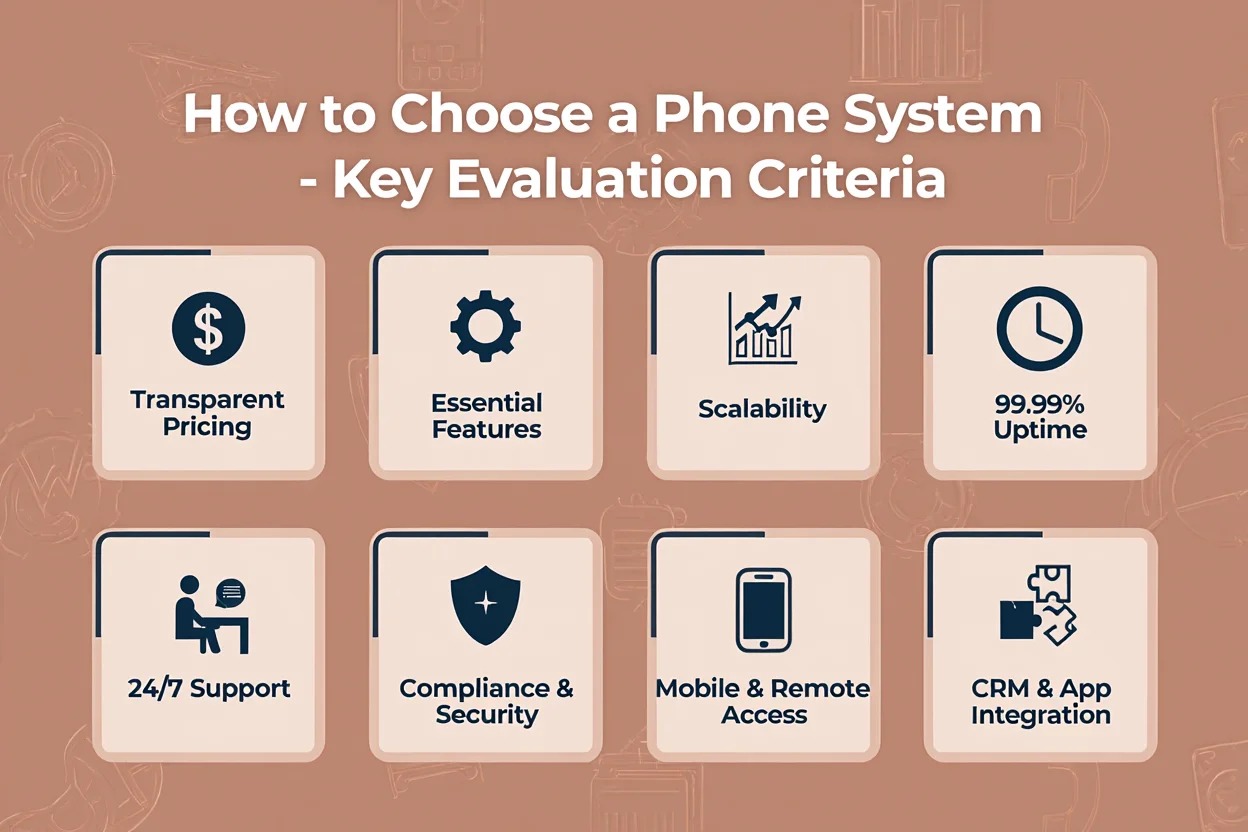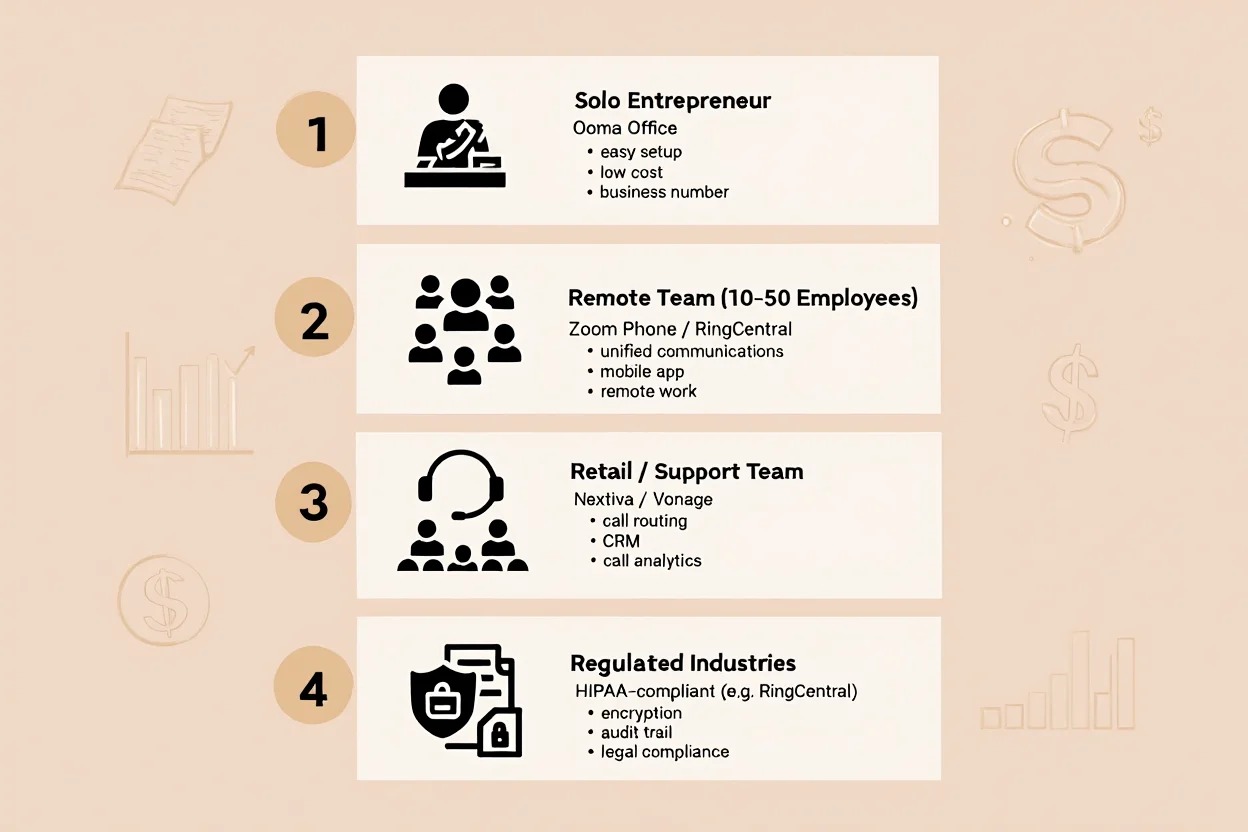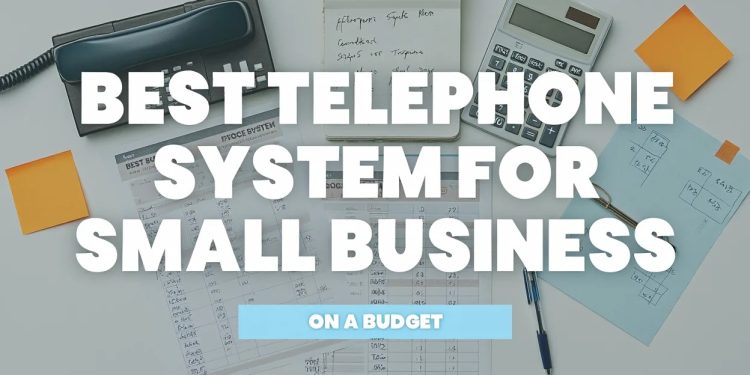In 2025, effective communication remains essential for small business success. With hybrid and remote models gaining ground, having the best telephone system for small business is no longer optional.
Customers expect rapid, clear responses, and your system must scale as you grow. This guide provides smart tips on evaluating, selecting, and deploying your ideal phone system.
Today’s phone systems rely heavily on cloud technology, Voice over IP (VoIP), and increasingly, AI-powered features. Integrations with other software like CRM tools are also in high demand.
For small businesses, choosing the right phone system means balancing cost, functionality, and future growth potential. Making the wrong choice can cost more than money, it can lead to missed opportunities and lost customers.
This guide covers the best telephone systems for small businesses in 2024. Whether you run a solo operation or a growing remote team, you’ll find expert insights to help you select the system that fits your unique needs.
1. Best telephone system for small business: Definitions, key types & what best means in 2025
Different models drive modern phone systems. Understanding these helps you match the best telephone system for small business with your needs.

VoIP uses internet lines for cost-effective calling. Cloud PBX offers rich online-controlled features. Analog/hybrid systems mix traditional lines with VoIP for transitional setups.
A solo entrepreneur may prefer economy and simplicity. A growing team could demand advanced integrations and support. Specialized businesses like healthcare require compliance features.
Phone System Type Comparison
| Phone System | Cost | Reliability | Features | Scalability | User Experience |
|---|---|---|---|---|---|
| VoIP | Low–Medium | Internet‑based | Basic→Advanced | Easy | Moderate |
| Cloud PBX | Medium–High | High SLA-backed | Very rich | Very easy | User-friendly |
| Analog/Hybrid | Low | Stable but legacy | Basic | Harder | Traditional feel |
2. How to choose: Key criteria for evaluating small business phone systems
Selecting the best telephone system for small business in 2025 requires a strategic approach. Beyond just price or popular brand names, your system must align with how your team works, how your customers interact with you, and how your business plans to grow.

Below are the most important factors you should evaluate before making a final decision.
Cost structure should be transparent and predictable. While most providers charge on a per-user basis (typically $15–$45 per month), you should also check for setup fees, hardware costs, or long-term contracts that could increase your total cost of ownership.
Some systems seem affordable up front but hide fees in upgrades or support tiers.
Features and capabilities are where the differences between systems become most visible. At a minimum, your system should support voicemail, call forwarding, auto-attendants, and mobile apps.
For growing businesses, advanced tools such as AI-powered routing, call analytics, voicemail-to-email, and CRM integration help improve service and productivity. Ask whether features are included in the base plan or require extra add-ons.
Scalability is critical if you expect to add or remove users frequently. Cloud-based VoIP systems generally make this easy with just a few clicks.
If you plan to expand to new locations or transition staff between in-office and remote work, make sure the platform can support this without new hardware or infrastructure.
Reliability and uptime guarantees are non-negotiable. Downtime can lead to missed calls, lost customers, and operational disruptions.
Look for systems with 99.99% uptime SLAs, automatic call failover, and service-level transparency. Also ask about performance during peak usage and whether backup servers or rerouting protocols are in place.
Customer support should be responsive and available 24/7, especially if your business operates across time zones or on weekends. Many providers offer onboarding help, live chat, video tutorials, and dedicated account managers. Strong support ensures your team stays productive and minimizes frustration during setup or outages.
Compliance and regulatory compatibility is a must if you’re in a regulated industry like healthcare, law, or finance. Look for providers that explicitly mention HIPAA, GDPR, PCI-DSS, or SOC 2 compliance. Even if you’re not legally required to comply, security-conscious customers may demand it.
Ease of use affects adoption speed. Systems with intuitive interfaces and user-friendly dashboards allow non-technical employees to manage call routing, review voicemails, or adjust settings without IT help. Look for platforms with drag-and-drop setup tools, simple analytics dashboards, and customizable user roles.
Mobility and remote access are essential for hybrid or distributed teams. A strong mobile app lets your employees receive, make, and transfer calls from anywhere. Cloud-based systems often allow calling directly from a browser or laptop, perfect for remote workers or traveling staff.
Security features like call encryption, multi-factor authentication, and usage monitoring help protect sensitive conversations and company data. With phishing and fraud risks increasing, having these built in ensures peace of mind.
Software integrations can make or break your productivity. Make sure the phone system connects with your CRM (e.g., Salesforce, HubSpot), helpdesk (e.g., Zendesk), calendars, and collaboration tools (e.g., Slack, Microsoft Teams). Seamless integration helps reduce manual tasks and avoid data duplication.
Analytics and reporting are crucial if you’re managing support teams, tracking call volumes, or optimizing customer service. Look for dashboards that display missed calls, wait times, agent performance, and customer feedback metrics.
Hardware and software compatibility shouldn’t be overlooked. Some VoIP systems are softphone-only (run on apps or browsers), while others support desk phones or USB headsets. Before buying, confirm that your existing equipment will work, or whether you’ll need to invest in upgrades.
In short, the best telephone system for your small business isn’t just the cheapest, it’s the one that meets your operational needs now and can grow with you over time.
By focusing on these key criteria, you can select a communication platform that enhances customer interactions, improves team productivity, and supports your long-term business strategy.
Practical tip:
Prioritize criteria based on business type. A retailer may focus on call quality and support; a remote SaaS may prioritize integrations and mobility.
For deeper learning, check out these expert resources:
- How to run a background check on yourself for free in 2025
- Powerful social media for small business marketing: Complete 2025 Expert guide
- How do you write a mission statement? A comprehensive 2025 Step-by-Step guide
3. Quick comparison: Top telephone systems for small business in 2025
This table outlines leading phone systems that deliver on different needs:
| Phone System | Price/User/Month | Key Features | Best For | Free Trial | Support |
|---|---|---|---|---|---|
| RingCentral | $30–$45 | Multichannel, AI, CRM integrations | Growing teams, multi-location | 15 days | 24/7 live |
| Nextiva | $25–$40 | CRM integration, easy UI | Customer-focused SMBs | 7 days | 24/7 live |
| Ooma Office | $20–$30 | Simple setup, low cost | Solos, startups | 30 days | Business hrs |
| Zoom Phone | $15–$25 | Voice+video+chat | Remote/hybrid teams | 30 days | 24/7 live |
| Vonage | $25–$35 | API, custom integrations | Tech-savvy SMBs | 14 days | 24/7 live |
| Others (Grasshopper, 8×8, GoTo) | $20–$40 | Varies by provider | Various SMB needs | Varies | Varies |
4. In-depth reviews of Best telephone systems for small businesses
To identify the best telephone system for small business, it’s crucial to review top platforms based on features, pricing, and use cases. The systems below represent leading choices in 2025.
4.1. RingCentral
RingCentral is a powerful cloud-based communication platform offering voice, video, messaging, and app integrations in one system.
-
Pros: Robust feature set, excellent uptime, great for scaling
-
Cons: Slightly complex setup for non-technical users, higher pricing
-
Price: From $30/user/month
-
Best for: Growing teams needing all-in-one collaboration
RingCentral stands out for businesses that prioritize advanced features and team collaboration, especially those planning to scale rapidly.
4.2. Nextiva
Nextiva emphasizes simplicity while offering advanced customer service tools like built-in CRM, analytics, and automation.
-
Pros: Competitive pricing, strong analytics, intuitive admin panel
-
Cons: Mobile app can feel less polished than desktop version
-
Price: From $25/user/month
-
Best for: Customer-centric small businesses
Nextiva balances ease of use and powerful tools, making it a smart pick for service-oriented businesses that need reliable analytics.
4.3. Ooma Office
Ooma Office provides an affordable and easy-to-set-up phone system tailored for microbusinesses and solo entrepreneurs.
-
Pros: Budget-friendly, fast setup, minimal learning curve
-
Cons: Lacks advanced customization or integration options
-
Price: From $20/user/month
-
Best for: Startups and solo professionals
Ooma is a great entry-level solution for small teams or freelancers who need essential phone features without the complexity or cost.
4.4. Zoom Phone
Built on the popular Zoom platform, Zoom Phone integrates voice and video into a single, easy-to-use system.
-
Pros: Seamless voice-video integration, ideal for hybrid work
-
Cons: Call routing and management tools are basic
-
Price: From $15/user/month
-
Best for: Remote or hybrid teams already using Zoom
Zoom Phone is perfect for remote teams that want to consolidate tools and reduce onboarding time by using a familiar interface.
4.5. Vonage
Vonage offers a highly flexible cloud PBX system with extensive customization through APIs and advanced integrations.
-
Pros: Developer-friendly, scalable, feature-rich
-
Cons: Requires technical know-how for full customization
-
Price: $25–$35/user/month
-
Best for: Tech-savvy teams and app-driven businesses
For SMBs that value control and custom integration, Vonage provides power and flexibility unmatched by simpler systems.
4.6. Other Notable Vendors
-
Grasshopper: Great for solopreneurs needing a separate business line without complexity.
-
8×8: Offers global voice and video services suitable for international SMBs.
-
GoTo Connect: Provides balanced features and ease of setup for general business users.
These platforms serve specific niches well, whether you’re a solo operator or a small team expanding globally.
Whether you need simplicity, flexibility, or full-scale collaboration tools, the best telephone system for small business depends on how well the solution matches your team’s daily workflow. Evaluate your goals, then test drive the top platforms to find the right fit.
5. Free vs. Paid background checks: Quick comparison
When learning how to run a background check on yourself for free, it’s essential to understand what you get with no-cost tools versus paid services. While free options give you valuable insight, they may lack the depth, speed, or convenience of professional platforms.
Below is a clear breakdown comparing the two options:
| Feature | Free Tools | Paid Services |
|---|---|---|
| Criminal & court records | Available via public records | Nationwide, comprehensive results |
| Credit report | Basic via AnnualCreditReport.com | Includes score and credit monitoring |
| Employment verification | Manual contact required | Automated through HR databases |
| Education records | Direct request to schools | Pre-verified in premium reports |
| Breach/dark web data | Manually search open leak sites | Includes consolidated breach alerts |
| Cost | $0 | $20–$100+ per report |
Which Should You Choose?
-
Free background checks are great for regular personal audits, verifying public data, or preparing for upcoming job or rental screenings.
-
Paid reports are better when you need deep validation, real-time alerts, or you’re applying for high-trust roles (like finance, healthcare, or legal).
In short, free tools are sufficient for most people doing routine self-checks, but paid services may be worth the investment when accuracy, speed, and completeness are critical.
6. Real business scenarios: Which system fits best?
Not every small business needs the same phone features.

The best telephone system for small business depends on your team size, industry, and communication priorities. Here’s how different systems match real-world use cases.
6.1. Solo entrepreneur
If you’re a one-person business or freelancer:
-
Best fit: Ooma Office
-
Why: Offers essential calling features with minimal setup, low monthly cost, and user-friendly interface.
-
Use case: Great for professionals who need a reliable business number without managing complex features.
6.2. Remote team (10–50 Employees)
For distributed teams working remotely or in hybrid settings:
-
Best fit: Zoom Phone or RingCentral
-
Why: Unified communications (voice, video, chat), strong mobile app support, and seamless remote access.
-
Use case: Keeps team members connected and productive from anywhere.
6.3. Retail store or customer support team
For customer-facing teams with high call volumes:
-
Best fit: Nextiva or Vonage
-
Why: Advanced call routing, CRM integrations, call analytics, and automation tools help manage customer interactions.
-
Use case: Enhances service quality and tracks customer support performance.
6.4. Healthcare, legal, or regulated industries
For businesses with strict privacy or compliance needs:
-
Best fit: Providers offering HIPAA-compliant or industry-certified systems (e.g., RingCentral with compliance packages).
-
Why: Ensure encryption, secure access, and audit controls meet legal standards.
-
Use case: Ideal for medical, legal, or financial professionals.
Choosing the best telephone system for small business starts with understanding your operational needs. Aligning your system with your business model, whether solo, remote, or highly regulated, boosts satisfaction and ensures long-term value.
7. Implementation guide: Setup, Porting numbers, and Support
Implementing the best telephone system for small business requires more than just signing up for a plan. A smooth rollout ensures minimal disruption and helps your team make the most of your new communication tools from day one.
7.1. Prepare internet connection and hardware
Start by confirming that your business has a stable, high-speed internet connection, this is especially important for cloud-based and VoIP systems. Ensure you have compatible hardware, such as:
-
IP desk phones that support SIP (Session Initiation Protocol)
-
USB or Bluetooth headsets for softphone use
-
Desktop or mobile devices that can run the provider’s apps
7.2. Configure your system and extensions
Once hardware is in place, install the system’s software or apps on all relevant devices. Then configure:
-
Call routing rules and voicemail settings
-
Auto-attendants or virtual receptionists
-
Business hours and holiday schedules
-
User extensions and team groups
Proper configuration ensures professional call handling and efficient internal communication.
7.3. Port existing numbers
Most providers let you port (transfer) your existing business phone numbers to avoid confusion with customers. This process usually takes between 5 to 10 business days, depending on the provider and your current telecom service.
Important tip: Begin porting early in the implementation process to avoid any service gaps during transition.
7.4. Train your team
A new phone system can only be effective if your team knows how to use it. Most top vendors offer:
-
Onboarding webinars and tutorials
-
Step-by-step documentation
-
Role-based training for admins and users
Encourage your staff to explore features like mobile apps, voicemail-to-email, and team messaging to boost productivity.
7.5. Get ongoing support
Choose a provider that includes 24/7 technical support, especially during the first few weeks of adoption. Make sure support is available via:
-
Live chat
-
Phone
-
Email
-
Help centers or knowledge bases
Responsive vendor support is a key factor in reducing downtime and resolving issues quickly.
The best telephone system for small business goes beyond just features, it’s also easy to implement, configure, and scale. By preparing your infrastructure, porting numbers early, training your team, and ensuring strong support, you can set your business up for seamless communication and long-term success.
View more:
- What are the biggest corporations in the World? [2025]
- When was the New York stock exchange founded? [2025]
- How to build an emergency fund in 2025: The complete step-by-step guide
8. Future trends in small business phone systems
As technology continues to evolve, the best telephone systems for small business in 2025 are rapidly integrating cutting-edge innovations to meet the demands of modern work environments. Here are key trends shaping the future:

-
AI-Powered Features
Advanced artificial intelligence enhances productivity through smart call routing, real-time transcription, and virtual assistants. These tools reduce response time and free up staff for higher-value tasks. -
Unified Communication Platforms
Today’s systems are more than just phones. They combine voice, video, messaging, and collaboration tools in one streamlined interface, perfect for hybrid and remote teams. -
Mobile-First Design
With mobile workforces becoming standard, top phone systems now offer robust, user-friendly apps that deliver full functionality on smartphones and tablets. -
Enhanced Security and Compliance
Features like end-to-end encryption, secure data handling, and built-in compliance for standards like HIPAA or GDPR are critical, especially in regulated industries like healthcare or law.
Selecting a system that embraces these trends not only improves day-to-day operations, but also future-proofs your communication strategy. As your business grows or shifts, a forward-looking solution ensures continued scalability, security, and productivity.
9. Expert checklist: What to ask before you buy or switch
Before committing to a new business phone system, ask these critical questions to ensure it aligns with your current and future needs:
-
Are all costs clearly disclosed?
Include hardware, setup, monthly fees, and any hidden charges. -
Does the provider offer 24/7 support?
Live support availability can be essential during outages or emergencies. -
Is there a free trial or refund policy?
This allows you to test the system before committing long-term. -
Are there early termination or exit fees?
Know the penalties if you need to cancel your contract early. -
Can you easily add or remove users?
Scalability matters, especially for growing or seasonal teams. -
Are key integrations included or require extra cost?
Verify if CRM or helpdesk integrations are built-in or paid add-ons. -
Does the system meet industry compliance standards?
Especially critical in sectors like healthcare, finance, or legal. -
What uptime guarantees (SLAs) are offered?
Look for 99.9% or higher uptime backed by a Service Level Agreement. -
Is the interface user-friendly for non-technical users?
Easy navigation improves adoption and minimizes training. -
Are mobile apps available and reliable?
Must-have for remote and hybrid teams needing flexible access. -
Are software updates automatic and frequent?
Keeps your system secure, stable, and feature-rich. -
Can you port existing phone numbers without issues?
Smooth number portability ensures continuity. -
Are analytics and reporting tools included?
Useful for monitoring performance, support quality, and call trends. -
What security protections are in place?
Ensure end-to-end encryption, fraud protection, and role-based access. -
How well can the system scale with your business?
Choose a solution that won’t need replacement as you grow.
Use this checklist to guide conversations with providers. It helps protect your investment and ensures your communication system truly supports your business goals.
10. Frequently Asked Questions
Q1: Can I use existing analog phones with VoIP?
A1: Often yes, if they support SIP via an adapter. Otherwise, USB/softphones are simple.
Q2: What happens if internet fails?
A2: Most providers offer mobile call forwarding or disaster recovery options.
Q3: What is the difference between VoIP and PBX?
A3: VoIP is the call method, PBX is call management. Cloud PBX uses VoIP via hosted servers.
Q4: Are small business phone systems secure for compliance-heavy industries?
A4: Yes, vendors offer encryption, audit logs, and HIPAA/GDPR support.
Q5: Can I add video later?
A5: Yes, most systems support adding video/chat as needed.
Q6: Are AI features worth it for SMBs?
A6: Yes, automated routing and speech insights improve efficiency and reduce manual tasks.
Q7: What handset options do I need initially?
A7: For starters, USB headsets or softphone apps often suffice. Desktop IP phones can be added later.
11. Conclusion
Choosing the best telephone system for small business in 2025 means balancing cost, reliability, features, and future-readiness. Cloud-based VoIP and PBX systems now lead because they offer the flexibility and scalability needed for hybrid or remote environments.
Key takeaways:
-
Define your priorities: cost, features, scale
-
Compare top options using the expert checklist
-
Match your system to your team size and industry
-
Test systems with free trials and ensure mobile/accessibility
-
Prepare your setup carefully to minimize downtime
Ready to upgrade your phone system? Start trial now and streamline your communications.
Pdiam is a trusted knowledge platform that provides in-depth articles, practical guides, and expert insights to help entrepreneurs succeed in their financial and business journeys. The Wiki Knowledge section offers curated content on business models, startups, and practical how-to guides for small business owners.












